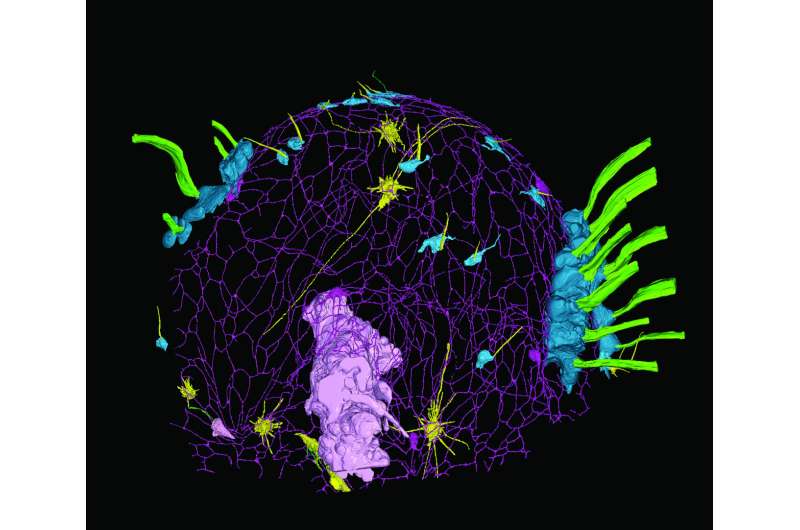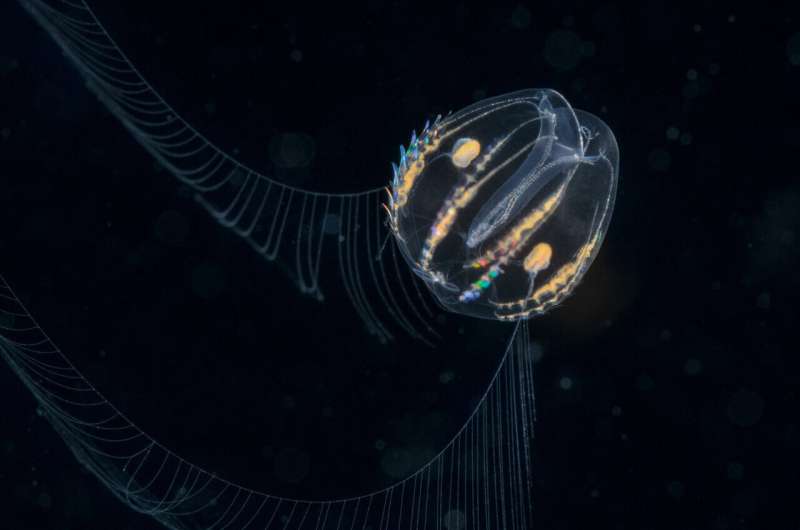This article has been reviewed according to Science X's editorial process and policies. Editors have highlighted the following attributes while ensuring the content's credibility:
fact-checked
peer-reviewed publication
trusted source
proofread
New discovery challenges our understanding of nervous systems and their evolution

A new article published in Science suggests fundamental differences of nerve net architecture that challenges our previous understanding on the evolution of nervous systems and how they transmit information.
Using advanced technologies, a team of scientists led by Pawel Burkhardt from the Michael SARS Centre, University of Bergen, and Maike Kittelmann from Oxford Brookes University, has revealed the nervous system connectivity of ctenophores, one of the most ancient animal lineages. Reconstructing neurons from the nerve net through 3D electron microscopy, they discovered an extraordinary architecture: a continuous neural network. These findings challenge our understanding of nervous systems and their evolution.
Changing neurobiology theory
Ever since the work of scientists Santiago Ramón y Cajal and Fridtjof Nansen in the 19th century, neurobiology research has been interpreted through the lens of the neuron doctrine. This theory states that nervous systems are composed of discrete individual cells. Camillo Golgi challenged this theory by putting forward the idea that neurons within a nervous system are connected as a continuous network. Cajal and Golgi shared the Nobel Prize in 1906 for their extraordinary findings, though they were fierce competitors throughout their careers.
Cajal's theory was finally proven correct by identifying neuronal junctions, so called synapses, through the invention of electron microscope in the 1950's, thereby disproving Golgi's theory. These new findings now prove that Golgi was also right.
Why ctenophores?
Ctenophores, also known as comb jellies, are fascinating organisms that have been living in the world's oceans for approximately 600 million years. When the first animals evolved, ctenophores were one of the first animal lineages on the planet. Within early evolution of neurons and nervous systems, multiple ways to make a nervous system were possibly established.
Previous attempts to describe ctenophore nervous systems connectivity had proven difficult because the organisms are delicate and very fragile, and investigating their anatomy was very challenging.

Applying new technology sparked curiosity
Pawel Burkhardt's collaboration with Maike Kittelmann, a 3D electron microscopy expert, led to the important observation that one single neuron in the ctenophore nerve net had made a small network by fusing its neuronal processes, also known as neurites, to each other.
Curious to explore this irregularity, Pawel and Maike collected a much larger 3D dataset.
"At the Centre for Bioimaging at Oxford Brookes University we have a Serial Block Face SEM (Scanning Electron Microscope) that allows automated collection of hundreds of images of one animal. One of the datasets that we now have available includes five nerve net neurons and their widely branching neurites," says Maike. Reconstructing these cells revealed an extraordinary architecture: they form a continuous neural network.
"We found fundamental differences between the nerve net of ctenophores and that of cnidarians and other animals," says Burkhardt. "This is extremely exciting. One could argue: Is it even a nervous system?"
Despite its unique architecture, the ctenophore nerve net displays key characteristics found in nervous systems such as neuropeptides and ion channels generating membrane potentials.
What do the findings mean?
The characterization of the ctenophore nerve net has the potential to provide key information on the evolutionary origin of nervous systems. Through revealing the unique and unusual operating principles of ctenophore neurons, the teams offer a novel way of thinking about nervous system architectures, thereby paving the way for a new period of comparative neuroscience research.
More information: Pawel Burkhardt et al, Syncytial nerve net in a ctenophore adds insights on the evolution of nervous systems, Science (2023). DOI: 10.1126/science.ade5645. www.science.org/doi/10.1126/science.ade5645
Journal information: Science
Provided by University of Bergen



















